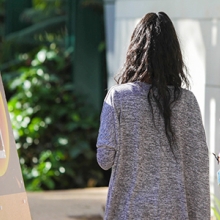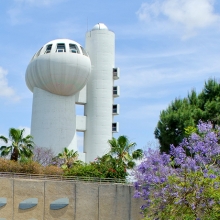Roy Naor
Simulating Mars
Students

It looks like Mars and feels like Mars but—it's Utah
For two weeks at the end of January, Roy Naor lived in a simulation of a Mars research station as a representative of the Israel Space Agency. The Weizmann Institute masters student and a team from four other countries were in an isolated capsule in the Utah desert, carrying out studies similar to those that might be carried out in the future on the Red Planet.
Naor, a native of Kibbutz Naan near Rehovot, is studying geology in the Department of Earth and Planetary Sciences, where he plans to pursue his PhD.
The Mars Desert Research Station is run by the Mars Society; in the 172 team simulated missions executed so far, members work in the arid, Mars-like environment to develop new technologies and gain insight into how people could live on Mars. The Utah desert’s topography, isolation, and soil quality is as close to what Mars is expected to be like as one could get in North America. This mission also included the head of the Slovakian Space Agency, a French mechanical engineer, an Australian astrobiologist, and an Irish artist.
The Israel Space Agency invited the public to participate in Naor's adventure by voting on the Israeli food that he would bring with him—Israeli salt and the peanuty snack Bamba won—and the song he should play for his team—“Halalit” (spacecraft) by Gazoz.
One of the team’s goals was to investigate carbonate minerals, which have been found on Mars and could provide evidence for liquid water in the planet’s past. Naor had an additional goal: to investigate the possibility of using the soil to create housing structures. One of the biggest technical hurdles to overcome in exploring Mars is its habitability— shelter, food, water. (Not to mention the ability to return home; it takes 7 months to get there and two years to return. But astronauts would die of starvation first, if not exposure to radiation or the loss of fuel.) One of the Utah mission scientists investigated the crops that might be grown on Mars, for instance.
Naor sampled and analyzed the geology of the environment, investigating the properties of the soil and using a 3-D printing technique, which involves synthesizing a three-dimensional object with a computer using successive layers of material. He then tested it to see whether the material has the required strength and the durability to withstand the radiation on Mars, to use for building structures.
So, how did it go? “I learned a lot,” he says, “but I brought back samples to the Institute for further testing. It’s a work in progress. And of course, it’s Utah soil—not Mars. I have to compare our results with what we know about the soil on Mars.”
To simulate living in a Mars station, the group lived together in cramped conditions, eating, working, and sleeping in a single structure, with showers limited to once every three days. They could only venture outside the station in groups, in full suits—including helmets and oxygen tanks. They were only allowed to communicate with “Earth”—the outside world—once a day, with a delay of several minutes; cell phones were forbidden. They had to ration their food over two weeks.
“It was intense and it was important,” he says, adding that the experience only heightened his desire to “inspire the next generation.” The mission generated media headlines and Naor described his experience on a series of Israeli news programs upon his return, which he hopes will kindle curiosity among youth. To that end, he teaches a course at the Davidson Institute of Science Education for high schoolers interested in space exploration. His dream: to create a Mars simulation habitat in Mitspeh Ramon in the Negev Desert, where the terrain and climate are similar to Utah—and as similar to Mars as possible here on Earth.
As for traveling to Mars, Naor says he’s game, “but I’ll wait patiently until they figure out how to get us back.”








